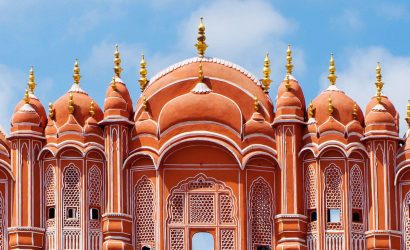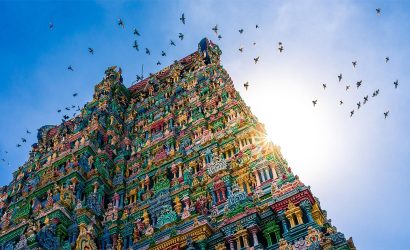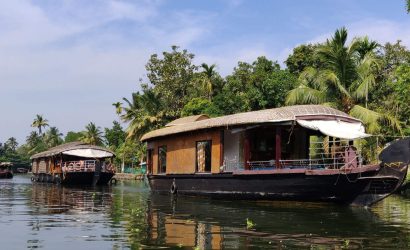Overview
Rajasthan, the largest state in India by territory, beckons with its vibrant crafts and textiles, awe-inspiring Rajput architecture, and vast desert landscapes. This enchanting land offers a multitude of captivating experiences, including the renowned Pushkar Camel Fair, a lively spectacle. Moreover, Rajasthan boasts four iconic cities, each adorned with its unique hue: Jaipur, the Pink City, a jewel on the Golden Triangle tourist circuit with Delhi and Agra; Jodhpur, the Blue City, famous for its majestic hilltop fortress; Udaipur, the dreamy White City, nestled beside picturesque lakes; and Jaisalmer, the Golden City, adorned with sandstone edifices and a magnificent fort.
Itinerary
Upon arrival at Delhi International Airport, you will be given a special welcome with mouli*.
Delhi, one of the oldest cities in the world, is a perfect concoction of the oldness and the modernity thus giving you an experience of a full circle.
Overnight at the Hotel
(*) Mouli is a red cotton thread used as an element during religious ceremonies in India. This thread is believed to protect the person wearing it from evil. When tying the Mouli, 'mantras' are usually recited to invoke the spiritual power. Another significance is that it is tied at the time of making a resolution, at the beginning of the prayer ceremony. Symbolically, it is a reminder of the resolution. Mouli is tied on a man's right wrist and a woman's left wrist which represents the spiritual side of each respectively.
Your first day’s drive is to the stunning Shekhawati region often described as Rajasthan’s open air art gallery which is located 260 km from Delhi and takes about 5 hours to reach. It is continued by a chauffeur-driven private car journey to Nawalgarh.
Vibrant frescoes in beautiful havelis define Rajasthan’s art hub - Tucked away in northern Rajasthan is an outdoor art gallery for the Shekhawati region. Shekhawati was once a cradle for India's richest families, who built grand havelis and decorated them with frescos of jaw-dropping ideas and details.
En-route we will stop to visit Mandawa local. This town has been referred to as the "open art gallery" of Rajasthan because the entire Shekhawati region and not just Mandawa, is dotted with fascinating mansions (havelis) that have lavishly painted walls.
We will stay the night at the hotel and enjoy local cultural folk dance and Puppets show in the house of Hotel.
The delicious authentic traditional Rajasthani food can be enjoyed in our restaurant "Jharokha" which dazzles with the ornate lit chandeliers. Towards the evening, explore the “RoofTop" with the view of the town of Nawalgarh, a popular choice among our guests for feasting on the gourmet cuisine that our chefs so finely prepare.
Kicking off the morning with local town sightseeing then we will hit the road to Bikaner (Approx. 220 Kms/3-4 hours).
A walk around Nawalgarh will give you a glimpse of the opulent lifestyle of the wealthy merchants. It is a town in Jhunjhunu district and is part of Panchpana. Sheesh Mahal, Morarka Haveli, Bansidhar Bhagat Haveli, Chokhani Haveli, Morarka Haveli, Anandi lal Poddar Haveli, Ramdev Ji Temple, Laxmi Narayan Temple, Ganesh Temple, Gopinath Ji Temple, Kalyan Ji Temple, Surya Temple, Narsimha Temple, Shiva Temple are some places of tourist interest here. Every home here is adorned with finely painted murals that illuminate the desert landscape.
After enjoying breakfast at the hotel, we will proceed for a sightseeing tour of Bikaner. Present day Bikaner owes many of its finest buildings to one remarkable man, the late Maharaja Ganga Singh [1880-1943] who single-handedly transformed his backward feudal domain into Rajasthan greenery by building the Ganga Canal, turning the surrounding deserts into lush, green fields.
We will be visiting Junagarh Fort, one of the most interesting forts in Rajasthan. It was one of the few major forts of Rajasthan that was not built on a hilltop. Instead, it was built on the desert plains.
We will drive you to Osian (170 Kms / 3 Hrs). Osian Desert Camps in Rajasthan was a great trading centre on the silk route from the 8th to 12th century AD.
In the evening, you can enjoy the liveliness. The Thar desert can be experienced through various activities like camel safari, cultural shows with folk dances on sand dunes.
We will explore the magnificent red sandstone temple and Jain temples. Then we will continue to drive to Jodhpur.
Then in the city tour comes the Mehrangarh Fort, considered one of finest in all India. Sink in the luxury of walking through the old city of Jodhpur known as Blue City. Breathe in the air of Jodhpur markets as well. Jodhpur bazaars are teeming with an array of handicrafts, making them a treasure trove for shoppers.
Your stay is planned in one of the most iconic hotels in all of Rajasthan, the Ajit Bhawan. Every pore of Jodhpur tells its own tales of heroic tales that made legends out of kings and soldiers.
Jodhpur: Known as the gateway to the Thar Desert, Jodhpur is the second-largest city in the state of Rajasthan, India. Dubbed “The Blue City" most houses in the old city are painted a beautiful shade of indigo. While Jodhpur is largely a sprawling modern metropolis, enclosed within its old city walls is a labyrinth of winding, narrow medieval streets, and bazaars. Must-see attractions include the Umaid Bhawan Palace, one of the world's largest private residences; and the Jaswant Thada, an intricately carved white marble mausoleum.
We will give a full fledged start to the day with the Bishnoi Village Safari and explore the rural & traditional side of Jodhpur city, in a jeep ride accompanied by a guide. Here, you can watch wild animals in their natural habitats, many species of desert animals are found there, some of them are Antelopes, Gazelle, Domicile Crane, Rabbits, Blue Bulls, Migratory Birds, Peacocks etc. Apart from safari you will have an opportunity to see local potter and waver families. Famous for pottery, travellers can see people doing pottery, if you want you can also try pottery, we will completely demonstrate the way people here do pottery and will also help you in doing the same.
Commencing with a drive to Marwar Junction to get an amazing local train experience then traversing through passages of Aravali Mountain! It’s an insider cum offbeat experience of the countryside with locals. You board your train from Marwar junction to Kambli Ghat approx. 2 hour joy ride of metre gauge train, one of oldest train tracks.
(DE board at Kambli ghat and drive to Kumbhalgarh.)
Kumbhalgarh- Kumbhalgarh is a small town situated on the western range of Aravalli Hills near the city of Udaipur. Kumbhalgarh is famous for one of the largest forts in the country – the glorious and majestic Kumbhalgarh Qila! This awe inspiring fort also houses the world's second largest wall. It is a World Heritage Site included in Hill Forts of Rajasthan. Kumbhalgarh has seven fortified gateways. There are over 70 temples within the fort, both Jain and Hindu Temples. From the palace top, it is possible to see Kilometres into the Aravalli Range.
Start the day with a guided tour to Kumbhalgarh Fort. The entrance houses a massive gate known as Hanuman pole, a double-storeyed gate with octagonal bastions. The gate got its name from the stone image of Hanuman located in front of the gate, which was brought by Maharana Kumbha.
Ram Pol is the main entrance of the fort, there is another entrance towards the east, called Vijay Pol. There are five more gates between Ram Pol to Badal Mahal, the Palace built on the highest point of the fort. After an early afternoon check out from Ranakpur, we will drive to Udaipur, en-route visiting Ranakpur Temple; we will stop for Lunch at Vijay Valley Restaurant.
In the morning, we will drive to Udaipur. (Approx.91 Kms/ 3Hrs)
En route, we will visit the Ranakpur Jain temples, one of the best complexes of the Jain religion that stands out, particularly for its carved architecture and its abundantly decorated ceilings, 29 halls supported by 1444 different pillars.
Once we reach Udaipur, you can take time to relax at the hotel.
Udaipur: It is one of the most romantic cities of Rajasthan, also known as the city of lakes. Settled on the shores of Lake Pichola and surrounded by hills, Udaipur is in stark contrast to the arid deserts of the rest of Rajasthan. Marble palaces, beautifully laid out gardens and lakes make Udaipur seem almost like a mirage in the desert.
First treat of the day is the City Palace Museum. Overlooking Lake Pichola, the City Palace is a marble and granite marvel. As it is the largest palace in Rajasthan with exquisite craftsmanship, it is a must on every visitor's itinerary. The three mahals, Baari, Dilkush and Moti, the Suraj Gokhada of the Sun Balcony, the Mor Chowk known for its beautiful peacock mosaics; the shrine of Dhuni Mata and the Rana Pratap museum are the highlights of this complex.
Near the City Palace is the Jagdish Temple (built in 1651 A.D.), which houses some imposing sculpted figures and lavishly ornamented interiors. A short distance away is the Sahelion-ki-Bari or Maiden's Garden which has four pools and delicately carved kiosks and marble elephants.
Then in the afternoon, take a boat ride on the placid waters of Lake Pichola, which covers the City Palace and Jag Mandir, a retreat of the rebellious Mughal prince Shah Jehan, soon to be the creator of the incomparable Taj Mahal. Overnight at the Hotel.
While driving to Jaipur, we will make a stop at the magnificent Chittorgarh fort. The fort was serving the capital of erstwhile state of Mewar and is located in the present-day city of Chittorgarh. The fort covers 65 historic structures, which include four palaces, 19 large temples, 20 large water bodies, 4 memorials and a few victory towers.
This day’s first visit is to Amber Fort.
Amber Fort: It is situated on a picturesque and rugged hill and is a fascinating blend of Hindu and Mughal architecture.
You will then visit the Jantar Mantar or the Astronomical Observatory. This is the largest and best preserved of the five observatories built by Jai Singh II in different parts of the country. Explore the exotic 'bazaars' of Jaipur to discover the artistic richness of the region. We will dine at a local restaurant in the afternoon followed by local shopping of world famous block printings, gems and jewellery in the Pink City.
Closing off the day by touring Birla Temple to witness the nightly ritual of religious worship (Aarti) ceremony.
On our way to Agra, we will visit Fatehpur Sikri, the deserted red sandstone city that was built by Emperor Akbar as his capital. The city is remarkably well-preserved; visitors can see the Jama Masjid, the tomb of Salim Chisti and several magnificent palaces.
Then comes the star of the trip, India's most fascinating and beautiful monument: The Taj Mahal, constructed in 1653 AD by the Mughal Emperor Shah Jahan in memory of his favourite queen, Mumtaz Mahal. This perfectly symmetrical monument took 22 years of hard labour and 20,000 workers, masons and jewellers to build and is set amidst landscaped gardens.
Later we will visit Agra Fort, an imposing fortress on the banks of the Yamuna River, built by the Mughal Emperor Akbar, in 1565 AD.
We will drive from Agra to Delhi. Old Delhi includes the photography of the magnificent Red Fort, built on the banks of the River Yamuna by the Mughal Emperor Shah Jehan, as well as Raj Ghat, the memorial to Mahatma Gandhi. We will elevate the trip with a visit to the crowded lanes of Chandni Chowk, the busiest commercial area of the city, bringing to life all the atmosphere of an oriental bazaar (Market).
You will be dropped at Delhi Airport.




